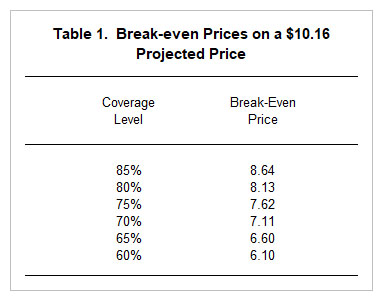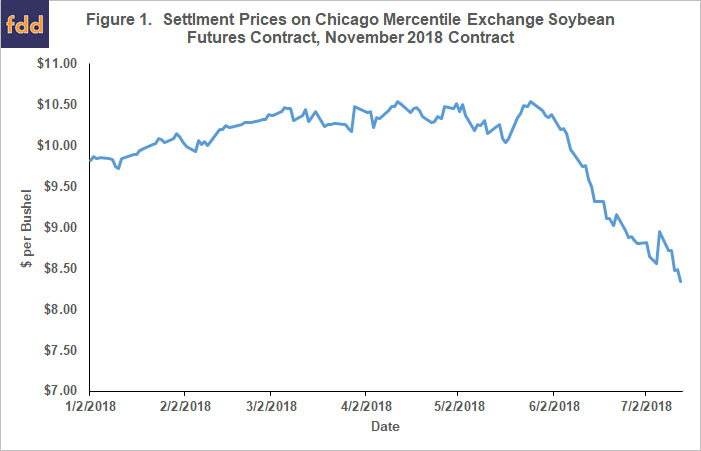Will Soybean Crop Insurance Payments in 2018 Offset Low Prices?
Trade disputes have roiled commodity markets and created substantial uncertainty about the impact on agricultural exports, especially to China. China’s response to the Administration’s proposed tariffs included tariffs on U.S. soybeans exported to China, and prices for soybeans have fallen dramatically (Farm Policy News, July 15, 2018). Price declines raise questions regarding whether revenue-based crop insurance policies will make large payments in 2018. Price declines raise the chance of indemnity payments on revenue insurance policies and, if large enough, could result in loss ratios above 1.0. It is more likely, however, that crop insurance indemnity payments will be less than total premiums paid on crop insurance policies, particularly if soybean yields this year are relatively high, as expected given current conditions. Most importantly, large soybean insurance indemnities will indicate that incomes on Midwest grain farms will be low.
Projected and Harvest Prices
In Midwest States, around 75% of the corn and soybean acres planted are insured with Revenue Protection (RP), with over 50% of the acres being insured at 80% and 85% coverage levels (see farmdoc daily, January 23, 2018). RP is a revenue insurance policy that triggers an indemnity payment when harvest revenue is lower than a revenue guarantee. The revenue guarantee equals the chosen coverage level times a guarantee yield (either the Actual Production History (APH) or Trend-Adusted APH yield) times the higher of the projected price and harvest price. This year, the harvest price likely will be below projected price, causing the guarantee to be based on the projected price. Large payments could result from RP if the harvest price is well below the projected price. Of course, yields relative to guarantee yields play a role in determining the size of crop insurance payments.
For Midwest states, the 2018 projected price is $10.16 per bushel for soybeans (farmdoc daily, March 1, 2018). This projected price is the average of settlement prices on the Chicago Mercantile Exchange (CME) November soybean contract during February. Useful indicators for evaluating whether crop insurance policies may pay are break-even prices, which can be calculated using the projected price times the coverage level of the crop insurance policies (see Table 1). The break-even price for an 85% RP policy for soybeans is $8.64 ($10.16 projected price x .85 coverage level) if yields are at the level of the guarantee yield. RP will make payments when the harvest price is below this level and yield from the insured unit does not exceed the yield used to set the revenue guarantee.

Market Price Declines
In Midwest states, the harvest price is based on settlement prices of the November CME contract during the month of October. Given that markets are efficient, a good indicator of the harvest price is the current levels of the November CME soybean contract. Prices on the November soybean contract were over $10 per bushel from January 2018 through the beginning of May 2018. Since May, November contract prices have declined and the November contract has been trading around $8.40 per bushel in the middle of July (see Figure 1).

An $8.40 price is below the $8.64 break-even price for the 85% coverage level, indicating that payments will occur if yields do not increase above guarantee yields. The break-even prices for 80% and lower coverage levels are below the $8.40 current price on the November contract (see Table 1). As such, prices have not fallen enough to trigger indemnities without yield losses for RP policies with coverage levels below 80% (see Table 1).
Will Large Crop Insurance Payments Occur?
Even given the recent large price decline, RP on soybeans may not make large payments. Prices on the CME November soybean contract may rebound and the harvest price may be above the current $8.40 price level.
Moreover, yields higher than guarantee yields could result in low payments. To illustrate, Table 2 shows yields relative to guarantee yields below which RP will trigger payments. Take an 85% coverage level and an $8.40 harvest price. The yield relative to guarantee yield is 1.03. If a policy has a 50 bushel per acre guarantee yield, a yield above 51.5 bushels per acre will not trigger payments. In recent years, soybean yields have been significantly above trend (farmdoc daily, March 20, 2018, and farmdoc daily, October 25, 2016), with Illinois state soybean yield being over 4 bushels above trend every year since 2014. If soybean yields continue above trend in 2018, soybean RP policies will not make large payments at an $8.40 harvest price, even at an 85% coverage level. Current growing conditions over much of the nation indicate the potential for high yields, indicating that above trend yields are possible.

Overall, loss ratios have been low on soybean policies in recent years (see farmdoc daily, January 9, 2018). In Illinois, loss ratios on soybean crop insurance products have averaged .49 from 2000 to 2016, meaning that losses have been 49% of total premium paid in for crop insurance policies, well below the Risk Management Agency’s (RMA’s) goal of setting premiums that result in loss ratios near 1.0 over time.
Figure 2 shows a scatter graph of loss ratios for soybean policies sold in Illinois on RP and its predecessor products against the difference of harvest price minus projected price. The lowest difference occurred in 2008 when the harvest price of $10.36 per bushel was $3.00 per bushel below the $13.36 projected price. The loss ratio in 2008 was 1.12. Besides the price decline, state Illinois yields were 1.3 bushel per acre below trend in 2008. Hence, the 1.12 occurred with a combination of lower prices and lower yields.

Note that harvest prices being below projected price does not signal large crop insurance payments. For all other times when harvest prices were less than projected price, the loss ratio was below 1.0 (see Figure 2).
Summary and Commentary
At this point, the probability of having large payments on soybean insurance policies have increased, but large indemnity payments are not a foregone certainty. Final payments will depend on yields and changes in price levels during October.
Arguably more importantly, large soybean crop insurance payments will indicate very low farm incomes. As discussed previously, yields will need to be well above trend for 2018 grain farm net incomes to approach the 2016 -2017 average levels (farmdoc daily, July 10, 2018 and June 26, 2018). Even at $8.40 harvest price, yields will need to be near or below trend before crop insurance payments will occur. Yields that are below trend, however, mean that farm incomes will be even lower in 2018. Crop insurance payments could provide a backstop against very low incomes, but will not offset the losses being experienced by grain farmers this year due to soybean price declines.
YouTube Video: Discussion and graphs associated with this article
References
Good, K., “Chinese Tariffs Take Toll on Soybean Markets,” Farm Policy News, Department of Agricultural and Consumer Economics, University of Illinois at Urbana-Champaign, July 15, 2018.
Schnitkey, G. "2018 Income Projections After Recent Price Declines." farmdoc daily (8):126, Department of Agricultural and Consumer Economics, University of Illinois at Urbana-Champaign, July 10, 2018.
Schnitkey, G. "Exceptional Corn and Soybean Yields in 2017." farmdoc daily (8):49, Department of Agricultural and Consumer Economics, University of Illinois at Urbana-Champaign, March 20, 2018.
Schnitkey, G. "Impacts of Lowering Coverage Levels and Using Harvest Price Exclusion on Soybeans." farmdoc daily (8):12, Department of Agricultural and Consumer Economics, University of Illinois at Urbana-Champaign, January 23, 2018.
Schnitkey, G. "Crop Insurance Performance of Soybeans." farmdoc daily (8):4, Department of Agricultural and Consumer Economics, University of Illinois at Urbana-Champaign, January 9, 2018.
Schnitkey, G. "Soybean Yields in Illinois." farmdoc daily (6):201, Department of Agricultural and Consumer Economics, University of Illinois at Urbana-Champaign, October 25, 2016.
Sherrick, B. and G. Schnitkey. "Crop Insurance Decisions for 2018." farmdoc daily (8):36, Department of Agricultural and Consumer Economics, University of Illinois at Urbana-Champaign, March 1, 2018.
Swanson, K., G. Schnitkey, J. Coppess and N. Paulson. "Five-Year Income Projections for Grain Farms." farmdoc daily (8):117, Department of Agricultural and Consumer Economics, University of Illinois at Urbana-Champaign, June 26, 2018.
Disclaimer: We request all readers, electronic media and others follow our citation guidelines when re-posting articles from farmdoc daily. Guidelines are available here. The farmdoc daily website falls under University of Illinois copyright and intellectual property rights. For a detailed statement, please see the University of Illinois Copyright Information and Policies here.







